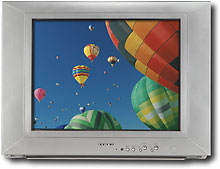CRT TV or Tube TV
The traditional tube TV, also known as a CRT (Cathode-Ray Tube) is a direct-view television and has been around for most of the past century. It is still in use in many homes around the world today.

How to select the right TV set
Most CRTs have an analog tuner, but some are digital. They are limited to displaying the 4:3 format full screen because the tubes are not manufactured in widescreen. They may be able to display the widescreen 16:9 format but it will show in letterbox form.
Click here fo information about Digital TV Formats
If you use an antenna or rabbit ears to receive your TV signal and you have an analog CRT TV or if it doesn't have a digital tuner, after the Digital Transition in 2009, you will need to buy a converter box to continue watching TV.
As of March 1, 2007, the CRTs have to be manufactured with a digital tuner. With a digital tuner, the TV can display free over-the-air digital broadcasts. Depending on your television’s capabilities, you may be able to receive HDTV.
Tube TVs are plug-and play. Aside from their weight, a CRT is about as easy as it gets. You put it where you want it, connect the signal (cable or antenna) and that’s it.
Fairly maintenance-free, the CRT television has a long life expectancy because it has no filters or lamps to change, and it is reliable. It has great quality, low cost and can be used with room lights on, or during the day with little change in image quality. CRTs are capable of delivering excellent black level, contrast and shadow detail. The flat screen tubes can be viewed at any angle and have very good picture quality.
CRT TVs have been made as large as 43 inches, but size, weight, and power limitations pretty much limit them to a maximum size of 36 inches. They are quite economical to manufacture, which keeps their prices much lower than any other display technology at present.
The tube television is perceived as “old” technology,
so it is not as “cool” as the new sleek flat screen digital TVs. There is really nothing wrong with the tube television and nothing old about the technology other than their screen size limitations and weight. As far as video quality is concerned, you can get beautiful HDTV pictures on these sets.
The direct-view HDTV tube television is very appropriate if you don't want or need a picture larger than about 36" diagonal, and don't mind how bulky it is. Other disadvantages include a certain amount of distortion, areas that are brighter and darker than others, and some regions that are not as focused as others. But these objections go unnoticed by most viewers.
Return from Tube TV (CRT) Information to EZ Digital TV Home Page